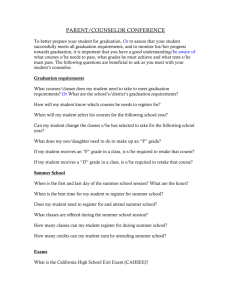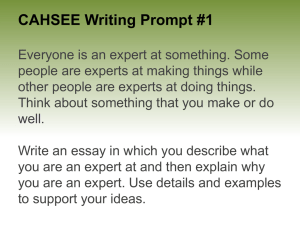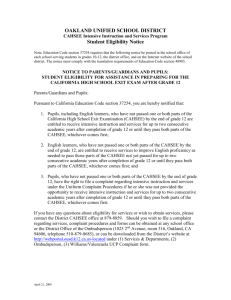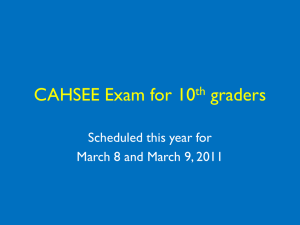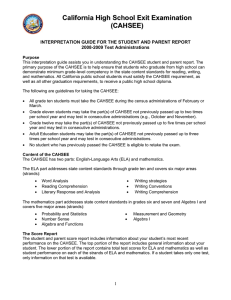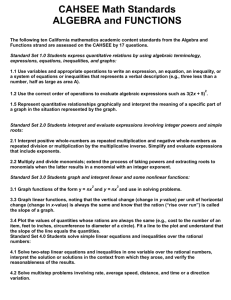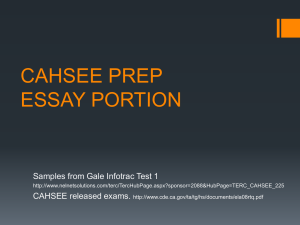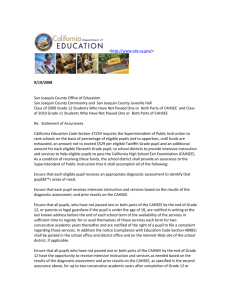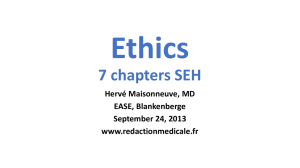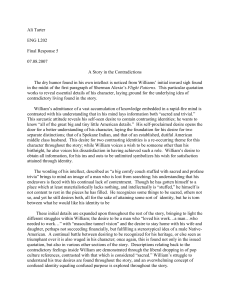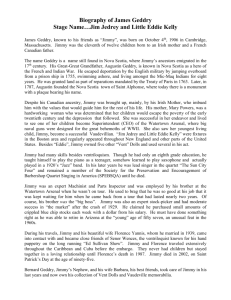Day 3 Power Point
advertisement
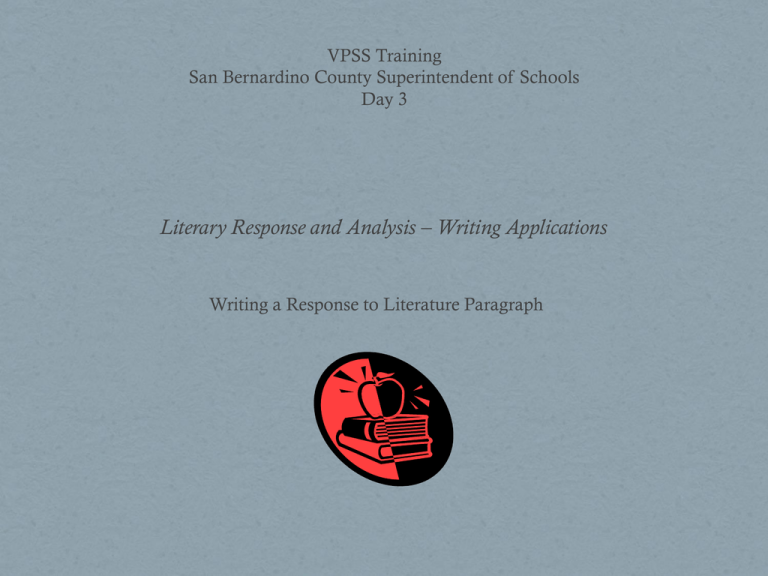
VPSS Training San Bernardino County Superintendent of Schools Day 3 Literary Response and Analysis – Writing Applications Writing a Response to Literature Paragraph 3-2-1 Review Activity • On an index card, write down three important points from Day 2’s reading, presentation, activities etc. • Share two of your thoughts with your table group. • As a table, select the one most important point you would like to share with the whole group. • Whip Around Asking Good Questions (Adapted from Rigor is NOT a Four-Letter Word by Barbara R. Blackburn, 2008) • Q – quality • U – understanding • E – encourage multiple responses • S - spark new questions • T – thought-provoking • I – individualized • O – ownership • N – narrow and broad • S – success building Q.A.R. Question-Answer Relationships Room as text • What time does the clock say? • How many people in the room are wearing glasses? • What would be the best way to arrange the tables and chairs in this room for discussions? • Would it be destruction of property or art to draw on the walls with markers? Level 1 • What time does the clock say? • What did you have to do to get this answer? • Right there Question Level 2 • How many people in the room are wearing glasses? • What did you have to do to get this answer? • Pulling It Together Level 3 • What would be the best way to arrange the tables and chairs in this room for discussions? • What did you have to do to get this answer? • Author and Me Level 4 • Would it be destruction of property or art to draw on the walls of this room with markers? • What did you have to do to get this answer? • On My Own Reading the Room - Write one question for each level • Right There • Pulling It Together • Author and Me • On My Own David • Read • Annotate text • Identify type of question • Answer the question You Try • Reread After Twenty Years • On your own, compose a question for each type. • With your table, decide on two questions for each type and write on the poster • QAR Carousel CST & CAHSEE Connection • Read through some of the Released Test Questions • With a partner, identify the “types” of questions asked on the tests. • The Study Guide can be downloaded from the CDE Website: http://www.cde.ca.gov/ta/tg/hs/elaguide.asp Goal: Respond to the prompt: Based on the characterization in the short story “After Twenty Years” by O. Henry, Jimmy is someone who would honor his friendship with Bob and honor his responsibility as a policeman. Activities and Assignments: Find three (3) examples in the text to support the premise of the prompt. Strategies: 1). Use the STEAL charts to record what the text reveals about the two. (2) main characters. 3). Use sentence frames to incorporate or paraphrase a quote from the story. Writing • According to researcher Douglas Reeves, writing improves reading comprehension and student performance in several academic areas, including social studies, science, and mathematics. • He also asserts that writing, particularly when paired with analysis, editing, and rewriting, will improve students’ abilities to communicate and succeed on state and local writing tests. Douglas B. Reeves, Reason to Write: Help Your Child Succeed in School and in Life Through Better Reasoning and Clear Communication. New York: Kaplan Publishing, 2002, p. 3. 7th Grade Writing Proficiency/California High School Exit Exam - CAHSEE The California High School Exit Examination (CAHSEE) requires all students to demonstrate their writing ability. As a result, the middle grades become a gateway for preparing students with the writing skills they need to succeed in high school and beyond. The seventh-grade writing proficiency results from the California Standards Test provide eighth-grade teachers with an important tool for assessing student progress and targeting strategies intended to bring students up to grade-level proficiency before the transition to high school. California Department of Education Publication - Taking Center Stage – Act II (TCSII) A Portal for Middle Grades Educators The 7th grade writing task should directly correlate with the CAHSEE writing task. • Compare Grade Seven and CAHSEE scoring rubrics: • genre • organization and focus • sentence structure • conventions Score 4 3 2 1 Genre Organization And Focus Sentence Structure Conventions Discuss Findings What did you find? What do we need to do to remain faithful to grade level standards and expectations and prepare our students for high school and beyond? The Writing Process • No matter how complex the writing task, it still breaks down to: pre-writing writing revising editing publishing REMEMBER Expect even your best students to take a long time to complete one (1) good, well-developed paragraph. What about Bob and Jimmy? Use a highlighter to mark what Bob says about himself and about Jimmy…this will make it easy to fill out the chart…create a chart for each character. Types of Indirect Characterization Speech Thoughts Effect on others Actions Looks Examples Explanation Based upon the characterization in the short story “After Twenty Years,” Jimmy is someone who would honor his friendship with Bob and honor his responsibility as a policeman. Find three (3) examples from the text that support your choice. Practice and Discussion Share out pre-writing ideas from STEAL charts and “Based upon…” • Why are these effective strategies? • What are some ways you might adapt the strategies for your student population? Sentence Frames The best way to learn how to write is to read as much good writing as you can. _________________ and _______, in their book ____________________, contend that _________________. Use the sentence frames handout to refashion your ideas for the paragraph. Practice and Discussion Share out sentence ideas. • Why is this an effective strategy? • What are some ways you might adapt this strategy for your student population? Next Steps Decide why these are/are not good examples to showcase the honesty of Jimmy’s character. The product of this discussion can become the basis of the commentary. Then: writing/editing/revising/publishing. Grading “Comment rather than correct.” • Address writer by name • Begin with a positive • “However” or “But” – suggest ways the student could improve the essay Jago, Carol. Papers, Papers, Papers An English Teacher's Survival Guide. Chicago: Heinemann, 2005. Sample Comment Dear Sam, Your essay exudes an enthusiasm for Gaines’ story that is infectious. Be careful not to allow your strong feelings for the book turn what should be an analytical essay-remember the key prompt verb: ANALYZE-into an evaluation of the novel. This shouldn’t be a book review but an analysis of the irony; implicit in the teacher being the one who learns a “lesson.” Thanks so much for being such a terrific leader in your literature circle. You really helped your group understand what they read. Practice Scoring • Trade papers • Read the individual’s paper and write a comment to this person • Offer a rubric score based on the CAHSEE rubric we looked at earlier. Ten Tips for Handling the Paper Load 1. Do it now 2. Set aside extended periods of time for grading 3. Use a timer 4. Stretch between each paper 5. Investigate computer scoring 6. Use a rubric 7. Avoid reading papers when you are exhausted 8. No interruptions 9. Make sure your students read your comments 10. Save all student papers The Big Picture Take a look at the entire unit of study – How were metacognitive strategies embedded? How were the standards addressed and differentiated? What other ways might you adjust the structure of the lesson to meet the needs of your students? Lesson Plan Write a lesson that embeds the information you learned from today’s workshop for teaching writing of a literary analysis paragraph/essay. Standards: Writing 2.0 Write responses to literature (The standard varies by grade level.) Writing Resources • UHS Student Writer’s Handbook • Graff, Gerald, and Cathy Birkenstein. They Say/I Say The Moves That Matter in Academic Writing. New York: W. W. Norton, 2005. • Check out many other sources on the Internet • http://www.angelfire.com/wi/writingprocess/ Ticket Out the Door • Please use the sentence stems and complete your ticket out the door as a reflection of today’s learning. Works Cited Allsburg, Chris Van. The Mysteries of Harris Burdick. Boston: Houghton Mifflin, 1984. Beers, Kylene. When Kids Can't Read: What Teachers Can Do. Portsmouth, NH: Heinemann, 2003. Graff, Gerald, and Cathy Birkenstein. They Say/I Say The Moves That Matter in Academic Writing. New York: W. W. Norton, 2005. Jago, Carol. Papers, Papers, Papers An English Teacher's Survival Guide. Chicago: Heinemann, 2005. Marzano R. Designing and Teaching Learning Goals and Objectives: Classroom Strategies That Work. Bloomington, IN: Marzano Research Laboratory, 2009. Reeves, Douglas. Reason to Write: Help Your Child Succeed in School and in Life Through Better Reasoning and Clear Communication. New York:Kaplan Publishing, 2002.
